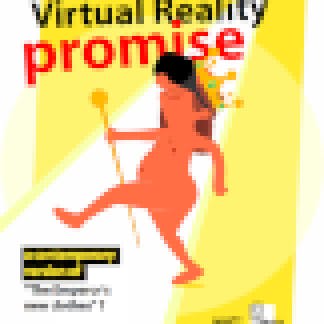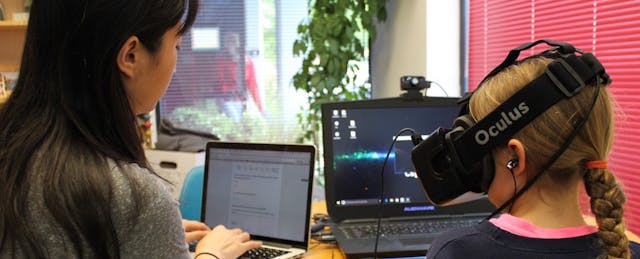What can virtual reality, the technology that arguably takes the viewer farthest away from the tangible world, teach students about expressing themselves and interacting with each other?
Two experiments at two very different California schools aimed to find out.
In May 2016 at San Jose’s Alpha Public Schools, a 13-year-old student named Jose met four Stanford computer science students bearing an Oculus headset and a laptop. Jose was among the first student to try Emoti, a virtual reality (VR) mindfulness exercise developed with the help of a $3,000 grant from inspirED, a partnership between Facebook and the Yale Center of Emotional Intelligence.
Jose put on the headset, headphones and, lastly, a watch-like device designed to measure stress by tracking heart rate and sweat. The first thing he saw was a beach set against a pink sunset—a calming backdrop. Emoti’s simulation then taught him a mindfulness exercise—breathe deeply as he pressed his middle finger to his thumb—with text, CGI demonstrations of the hand motions and verbal instructions.
To test stress levels and Jose’s capacity to lower them, Emoti was then tasked him with subtracting 13 from any number that appeared on screen until he made a mistake. He lasted several rounds, his heartbeat climbing. When he finally misfired and gave the wrong number, the simulation asked him to recall the breathing exercises and to use them to calm himself. It repeated its earlier suggestions about breathing and pressing his fingers together on screen till Jose’s heart rate returned to resting speed.
Why are they conducting this experiment? The members believe that social and emotional learning (SEL) in its current state doesn’t engender real feelings in students because it isn’t immersive. Often, SEL exercises involve students role-playing in pre-set scenarios that lack verisimilitude or immediacy. Understood.org provides the example practicing starting conversations with friends by roleplaying with parents: “Your child could compliment you, comment on the activity you’re involved in or ask a question about a common interest.” It is difficult to imagine a teenager volunteering to participate in such a stilted interaction.
Other scenarios make use of commonplace and overwrought trust exercises—selpractices.org advocates for “Minefield,” in which one blindfolded participant walks through an obstacle-laden field guided by shouting team members at a distance.
Feedback for such an individualized subject, Emoti team members say, should be personalized, which is difficult for teachers with large classes. That’s where virtual reality and its accoutrement come in. The idea behind the simulation is that it provides, through biometrics on stress levels, more individualized data and feedback on a student’s responses than a teacher could reasonably gather or give.
Greg Callaham, Alpha’s director of social and emotional learning, was excited about the demonstration. His school has begun implementing a comprehensive SEL curriculum, dubbed Personalized Leadership Training (PLT), over the past three years. Callaham works with coaches to integrate the subject with physical education.

The overall goal of the program, Callaham says, is to “prepare students for the emotions of college. Teach them to advocate for themselves and make connections by integrating these concepts with academics.” More than 90 percent of Alpha’s students are, if they matriculate, the first in their family to attend college, creating additional pressure in already stressful transition period.
Callaham believes in VR’s potential to create more in-depth SEL exercises for his students, even if the current efforts are nascent and untested. He also believes that students don’t often take in-person role-play scenarios seriously because the other participants are their friends and therefore also know that the scenario is fake. They’re in on the joke. Callaham often sees that students know the right answers to a scenario and therefore don’t have to struggle during the exercises. Teachers can’t create realistic demonstrations of conflict, Callaham thinks, but VR can create immersive environments for students to dive into. He says, “Getting to do a VR simulation also feels much different from ‘You have behavior problems,’ if, say, a student needed SEL remediation. That’s most likely when we’d implement it.’”

Thirty miles away, The Synapse School in Palo Alto was experimenting with VR at the same time as Alpha. Unlike the charter school, Synapse is a private school where yearly tuition is just under $30,000. It’s also a lab school for Six Seconds, a nonprofit that promotes emotional awareness among adults.
The private school integrates emotional intelligence, affectionately shortened to EQ, into every subject, much like Alpha has woven Personalized Leadership Training (PLT) into physical education. Marsha Rideout, director of admissions at Synapse, summarized the school’s motivation for emphasizing the quality: “IQ will get you your job, but EQ will keep it.” That mantra motivated Adnan Iftekar, Synapse’s technology and innovation specialist, to ask his students and fellow faculty members to think critically about VR.
“I asked everyone to look at the social responsibility we’re going to have” with virtual reality, he says. “We’re hoping that bringing SEL into our work with tech will educate students on the responsibilities they’ll have in these new spaces”
Iftekar worked with another group of Stanford computer science students, Versatile, to test a virtual experience called “Safe Flight,” another collaboration with Oculus, on 3rd and 4th graders. The students play as an astronaut, Ellie, who is in space with a limited oxygen supply. She’s been stranded by a broken elevator that normally runs between a space station and earth. Players can choose whether to help their fellow stranded astronaut (an in-game character) by giving up their own oxygen supply or keeping it to search for materials to repair the space elevator. Synapse students were so eager to participate that they had to write application essays to win a slot.
The Versatile team recorded their findings in a blog post: “The most commonly experienced positive emotions included: curious (71.4% of students), excited (57.1%), and surprised (50%) and confident (50%). The most common negative emotions experienced were: afraid (42.9% of students), confused (42.9%), and anxious (35.7%). 54.5% of students reported feeling concerned during the game.”

Despite the hubbub, Iftekar also believes educational VR is still very much in its infancy.
“The potential is huge, but we need to look at how something even more immersive than what we have now will affect us socially,” he said. “We’re trying to teach our students the difference between tech and tech behavior.” He thinks VR will improve and reach wider distribution in five years or so.
Why are edtech companies and teachers interested?
These experiments at Alpha and Synapse suggest a broader trend at work: SEL is being taken seriously by educators across the country. Some districts have struck out on their own: the Washoe County School District, comprised of 64,000-students living near Reno, Nevada, will implement its own SEL curriculum this coming school year. Whole states are even banding together to create standard curricula for the subject. In April 2016, the Collaborative for Academic, Social and Emotional Learning (CASEL) announced it will work with eight states to develop policies, guidelines and benchmarks for integrating SEL into their curricula. Forty states expressed interest. Their approach does not explicitly take technology into account.
“The key thing about SEL,” Alpha’s Greg Callaham said, “is thoughtfully and strategically integrating all the elements of instruction with one another, and that includes the technology. You can’t buy out-of-the-box SEL curriculum and expect it to fit your school. You can’t do that with tech either, though that approach is very common.”
The tech industry seems ready to lend support. A survey of roughly 1,000 teachers commissioned by Samsung (which sells its own VR headset) found that 60 percent of teachers wanted to employ VR in the classrooms—but that only two percent actually did. A recent Goldman Sachs report on the VR industry predicts that the market will be worth $45 billion in hardware sales and $35 billion in software sales by 2025. Of that, the investment bank estimates, educational VR will make up about $700 million.
“A year ago, when we were in classrooms, we weren’t talking about VR,” says Ted Brodheim, Vice President of Vertical Business at Samsung America and former Chief Information Officer at NYC Public Schools. “Now there’s been an uptick in interest in having students create their own traditional media and VR, which is good news.”
But significant obstacles exist, cost being one of the most significant. The Emoti team had traveled to Alpha to deliver a proof of concept, but they recognized the obstacles at play. A single Oculus Rift headset costs $600 and requires a computer powerful enough to run it, which would run about $1,000 to $2,000, according to Fast Company.
Most VR platforms also lack high-quality educational content, which begs the question, “What will you teach with this technology?”
The title of a report by MindCET, an Israeli education technology accelerator, asked bluntly whether virtual reality’s promise is “ a contemporary version of The Emperor’s New Clothes?” Despite the fact that VR startups have raised $1.2 billion in Q1 of 2016 alone, the authors say that “most of the actual end- consumers either haven’t yet heard much about this booming trend, or are highly skeptical about its relevance to the lives of anyone other than a few hard-core gamers and geeks.”
Photo courtesy of MindCET

But the report is ultimately optimistic. Cecilia Waisman, vice president of research and development at MindCET, believes that VR technology is still not everything it could be, but that isn’t a reason to discount it. She still feels there’s much she doesn’t know after nearly two years of research, a feeling she sees mirrored among other researchers, teachers and entrepreneurs.
“There’s a lot of buzz about VR—we’re still in the ‘wow phase’—but a contrasting lack of understanding of the pedagogical value,” she said. “We believe it has a huge potential, but it needs to be deeply explored. We need to find its value with teachers.”
Waisman has often heard from educators that products are handed down from on high by publishers, which makes for a frustrating experience when trying to tailor instruction to individual students. She hopes that the widespread conversation around VR will encourage teachers and students to become involved in designing and testing VR products. Their input will be critical, believes her colleague and MindCET CEO, Avi Warshavsky:
“Educators have said to me: ‘Call me when this is ready. Why are we wasting time with something that’s not cooked?’ I believe this attitude is a mistake. Educators who will be involved with VR will shape how it’s implemented in the classroom, what its functions are, and how the future looks.”


